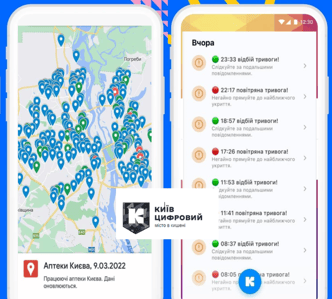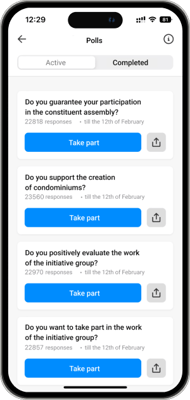Kyiv’s wartime innovation is a lesson in adaptability and resilience
When Russian tanks rolled into Ukraine in February 2022, the IT team at Kyiv City Council made the decision not to evacuate. Instead they jumped into action; findings ways to transform the city’s technology to keep citizens safe. In the months that followed, against a backdrop of economic and social hardship - which saw Ukraine's economy shrink by a third and millions of residents displaced - the capital underwent a series of innovations driven by necessity. Kyiv's journey is a lesson in adaptability and resilience.
“Ukraine was not ready for war but this is our reality now,” Oleg Polovynko, Chief Information Officer at Kyiv City Council, tells Government Transformation Magazine. "Every day, we wake up to a new set of challenges; we must devise swift responses to keep our citizens safe and services available.”
Before the invasion, Kyiv had started to digitise its public services through its transport information and booking system. The Russian invasion saw those pockets of early digital innovation become strongholds for resilience; keeping residents safe and critical public services open amid an unspeakably challenging time for the country.
A lifeline for essential services
In the early days of the invasion, Kyiv's IT team - roughly 20 employees - were focused primarily on developing a means to safeguard citizens from missile attacks. They incorporated a feature into the city's smartphone app that alerts residents of incoming missiles, guides them to the nearest bomb shelter, and indicates when the danger has passed.
"The Kyiv Digital app, initially created for smart mobility services such as transport and parking, and some public services like online booking and emergency notifications, was the logical choice," explains Polovynko. "It already had a notification function and was used by the majority of residents, so it made sense to use this channel to communicate information about what to do in the event of a missile attack. Today, it's a life-saving tool used by 2.5 million registered citizens.”
The Kyiv Digital app was transformed overnight by its developers. In just 24 hours as Russia invaded, it became a survival kit in people's pockets.
hours as Russia invaded, it became a survival kit in people's pockets.
Since then, the platform has unified essential city services through additional features designed to support the “basic life needs” of residents, Polovynko said.
When Google temporarily disabled live data on its Maps app in Ukraine, residents still required information on where to find the pharmacy, how to repair their car and which markets were open.
Polovynko explains that they essentially had to "recreate Google" by providing their own online map. This would allow residents to locate bomb shelters, find open pharmacies and grocery stores, as well as pinpoint access points for free water and bread.
Another initiative led by the digital team involved setting up an online form. This allowed business owners, who had been forced to temporarily shut down, to report when they reopened; information that was then promptly updated on the app's map.
Polovynko explains that when you are faced with new challenges under pressure, you are forced to get creative. But the best solutions are not overly complex: “They just need to provide people what they need at the right moment,” he says.
Keeping Kyiv connected
One of the biggest challenges faced by the team has been maintaining connectivity - a considerable feat amid missile attacks and prolonged power outages.
"Citizens are depending on our digital services to keep them safe and prepare them for whatever comes next. So, we had to find a way to keep as many people as possible connected to the internet, even when they were taking shelter in places with no connectivity," explains Polovynko.
In the early months of the war, mobile WiFi hotspots were repurposed from vacant offices and government buildings to be used in bomb shelters. Later, the IT team launched a feature on the city app, allowing people taking refuge in shelters to request for connectivity so that internet providers could offer services.
Within the first few months, 19 ISPs (both local and national) had participated, and over 800 shelters had been provided with a WIFI connection.
Kyiv’s digital office also worked with Ukrainian mobile operators to provide free roaming coverage for residents so that they can remain connected. Later, the digital team would use these analytics from mobile users to gauge the number of people in Kyiv so they could manage food rations.
Kyiv City Council’s top priority remains keeping citizens safe. But over time the digital team has expanded its focus; developing ways to help people go about their normal day. At the end of last year, an emergency awareness system was deployed in Kyiv, which means residents are able to receive notifications about the occurrence of an energy alarm. This alerts them to the risk of temporary disconnection or problems in the network, allowing people to plan their day in such conditions. “Life goes on” remarks Polovynko.
Digital democracy
Polovynko says he's committed to providing digital services that allow people to communicate their needs to the city council. One significant way his team is doing this is through electronic democracy services, such as voting on the Public Budget, a mechanism for constructive dialogue between the municipality and the public that gives residents a chance to vote on how money is spent for projects in the city.
“This is how we can make decisions that effectively provide people with the services they need,” Polovynko says.
There is also an e-petition service that allows users to view, support and monitor the progress of the petitions they have signed online. Since the introduction of this community-led service, over 1300 petitions have been registered and more than 1.5 million votes have been cast.
Among the most popular topics of e-petitions are transport and infrastructure - reflecting the real-life concerns of residents. The service allows for public participatory action, building solidarity among those who share a vision for the  future of the city.
future of the city.
While the e-petition service was in development before the Russian invasion, Polovynko says it has since assumed a new significance: “People can witness and experience e-democracy in action at a time when the war threatens to extinguish real freedom.”
This project has also been instrumental in safeguarding Ukrainian history and national identity. One e-petition that has gained traction since the Russian invasion last year advocates for the renaming of streets, public transport stations and squares in Kyiv - which are currently named after Soviet-era figures.
“People want the names of genuine Ukrainian heroes instead,” says Polovynko. “Citizens can click on the name of their neighbourhood in order to see which streets and squares are up for renaming and then vote on the new one.”
Finding ways to engage with citizens is the key to creating services that are adaptable and resilient, Polovynko explains.
“If a digital strategy is going to succeed, the needs of the citizens must always come first. This is the main role that any digital tool, funcion or vision should have. It must be user-centric, and the more engagement you have, the better and more resilient your service is going to be.”
Modelling for the future
Despite the ongoing invasion, the IT team at Kyiv City Council are already envisioning the future and planning ways to enhance the city.
Polovynko says they're in the preliminary stages of creating a digital twin of Kyiv; a 3D model that mirrors the city and which will be used to help reconstruct areas damaged by the invasion, and to evaluate the impact of initiatives like traffic control and quality of life for residents.
This is an opportunity for the city of Kyiv to be redesigned for the future, Polovynko explains. Cameras with licence plate recognition and speeding violations, smart traffic lights, and the ability to view vehicle geolocation in real time – these are all parts of the digital team’s daily work to make life better for Kyiv residents.
This is the ambition; the challenge is that they lack a big part of the data needed to create the digital twin. To overcome this, Polovynko says they are looking to partner with telecom providers in the city to obtain real-time data about road conditions and the control of traffic management. “The more data we collect, the better we can understand the pain points in Kyiv,” he says.
Outside of Kyiv, the Ukrainian government is already undergoing reconstruction efforts using twin technology in the Chernihiv region, in northern Ukraine.
Three French companies - Dassault Systèmes, Egis and B4 - have been appointed to combine their expertise in 3D modelling to construct more resilient and sustainable cities.
Reflecting on his time as CIO, Polovynko believes the challenges caused by Ukraine’s aggressor have made Kyiv “even more resilient, technologically advanced, and stronger than ever.”
He believes other countries can learn from Ukraine. "The world is unpredictable; changes are happening everywhere, from natural disasters to epidemics, you never know what's around the corner. When the war began, we became the government's sole means of communication and a lifeline for our citizens.
"Sometimes, there isn't a grand idea or vision; you simply need to create services that are as adaptable as possible, and that's precisely what we're doing in Kyiv."






